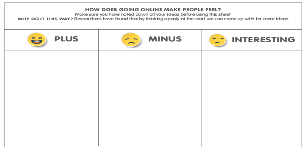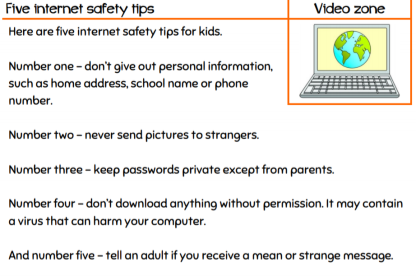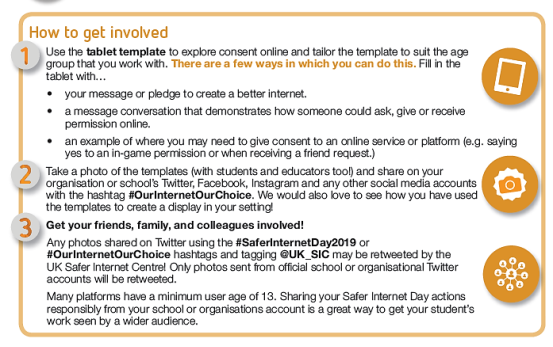Lesson-plan "Safer Internet Day"
|
Урок: |
|
Клас: |
|
Дата: |
06 |
02 |
2019 |
Вчитель: Мельник І.Є. |
|||
|
|
|||||||||||
|
Тема уроку: |
Технології зв'язку |
||||||||||
|
Підтема уроку: |
День безпечного інтернету |
||||||||||
|
|
|||||||||||
|
Тип уроку: |
урок формування навичок і вмінь. |
||||||||||
|
|
|||||||||||
|
Навчальна мета: |
|
||||||||||
|
|||||||||||
|
Розвиваюча мета: |
|
||||||||||
|
|||||||||||
|
|||||||||||
|
Виховна мета: |
|
||||||||||
|
|||||||||||
|
|||||||||||
|
|
|||||||||||
|
Формування компетентностей: формувати компетентності саморозвитку; виховувати здоров’язбережувальні компетентності , а саме уміння дотримуватись гігієнічних норм під час роботи за комп’ютером. |
|||||||||||
|
|
|||||||||||
|
Очікувані результати: Учні вдосконалили свої навички говоріння та аудіювання; попрактикували вміння писати та читати; потренувались виконувати різноманітні тести.
|
|||||||||||
|
Обладнання: |
Підручник, дошка, ТЗН, роздатковий матеріал. |
||||||||||
|
|
|||||||||||
|
Методи, форми і прийоми навчання: |
|||||||||||
|
Метод: |
інформаційно-рецептивний. |
||||||||||
|
Форма навчання: |
розповідь-пояснення, бесіда, робота з підручником, ТЗН, ілюстрації. |
||||||||||
|
Прийом навчання: |
Виклад інформації, пояснення, активізація уваги та мислення, прийоми запам’ятовування, одержання інформації з тексту та ілюстрації підручника, робота з додатковим матеріалом. |
||||||||||
Procedure
- Warming up:
- presentation:
Good morning students! Today I will be your teacher of English. My name is Inesa Yevhenivna. I am a teacher of English at school 12.
I see you are all interested in learning English. So, let’s start! Firstly, I would like to show you a video with the help of which you will guess the topic of our today’s lesson.
-
 topic: (video 1. Topic)
topic: (video 1. Topic)
So, who can tell me what the topic of the lesson is?
Yes, you are right, It’s Safer Internet Day! It seems you are in the world of English and you know the topic of the lesson. And I would like to remind you that Safer Internet Day is celebrated globally in February each year in over a hundred countries to promote the safe and positive use of digital technology for children and young people and inspire a national conversation. The day offers the opportunity to highlight positive uses of technology and to explore the role people play in helping to create a better and safer online community. It calls upon young people, parents, teachers, social workers and wider, to join together in helping to create a better internet.
- aim:
Your purpose of the lesson is to activate the vocabulary you’ve learned at the previous lessons, you are going to listen to the text and discuss the impact of digital life, moreover you will learn to express your attitude about going online. You also will develop further your reading, writing, listening and speaking abilities. It seems to me some of you will change your attitude to the way of surfing the Internet.
-
 Speaking: How does going online make us feel?
Speaking: How does going online make us feel?
Now I would like you to think about the emotions you most commonly associate with going online and then note them down. Only once you have done this, you should transfer those words to the table on the blackboard.
So do it in pairs. I give you 3 minutes to think of and write each emotion on a separate Post-It note and stick them on a table on the blackboard splitting them into 3 categories: +/-/neutral. This could form part of a display to celebrate Safer Internet Day.
Now, having completed the table let’s discuss the picture we have:
- Are there more positive or negative words?
- Can you agree a top 3 most commonly felt emotions?
- What was the most enjoyable and the most worrying emotion you came up with?
- How much can going online change your feelings or does it just reinforce how you already felt?
(use the prompts on the blackboard while answering the questions:
- No doubt the most commonly felt emotions are…
- According to my feelings I can distinguish the following …
- I am sure that...
- As for me, I feel that…)
3. Vocabulary Work:
Before starting to work let’s revise your active vocabulary and pronounce some words. Will you repeat after me?
privacy settings
social network site
upload
safe
account
public
logged in
delete
password
format
cell phone
screen
computer
the Internet
digital
screen
record
post
4. Reading. Work with the textbook:
And now open your books on the page 134. There is an ex. 8. There are a lot of sites for teenagers nowadays. Now read quickly the text and try to catch as much information given in it as possible. You have 3 minutes.
5. Writing:
If you have finished, let’s check how you have understood the text. Look at the board, and let’s do the quiz.
- You can get … and … on lot of topics.
- promise, suggestions
- information, offers
- advice, suggestions
- There is a … … for the service.
- monthly fee
- weekly allowance
- monthly payment
- Search for subjects, locations, financial … and more.
- help
- aid
- support
- Why look into your future?
- to get acquainted with your future friends
- to see your college life
- to find a college for you
- Be … you can find a perfect dress!
- attentive
- sure
- self-proclaimed
- “Family favourites” means …
- the things you like most
- close relatives
- parents
- “Sing along” is …
- sing alone
- sing together with somebody
- sing on the stage
- If you get suggestions, you …
- star in the film
- advertise your music preferences
- create a new video
- If you have at least one of your recordings, you may try …
- selling it online
- uploading it
- talking about it
- “Saving” means …
- keeping for a long time
- selling in the Internet
- posting to your friends
(Keys: 1. c, 2. a, 3. b, 4. b, 5. b, 6. a, 7. b, 8. c, 9. b, 10. a)
- Relaxation:
Everybody knows that though the computers have made our work easier, they do come with certain disadvantages as well. The rays emitted by a computer screen can be harmful to your eyes if exposed for an extended duration.
It is important that you take certain precautionary measures to protect your eyes:
1. Wash your eyes;
2. Get computer glasses (if necessary);
3. Watch the position of your screen.
4. Do eye exercise. So, let’s have a short rest. Follow the ball.

And now close your eyes and have a short rest.
- Listening: Online safety conversation
Now we are going to deal with the listening. So, you will hear the conversation between the mother and her son. They are talking about one big problem that you face with whiling surfing the Internet. But firstly let’s do the preparation exercise before you listen.
Look at your papers and do the first activity
- Pre-listening activity:
Match the words to make common phrases and write a-e next to the numbers 1- 5.
|
1 |
privacy |
a |
site |
|
2 |
social network |
b |
settings |
|
3 |
log |
c |
a photo |
|
4 |
upload |
d |
safe |
|
5 |
stay |
e |
in |
(Keys: 1. b, 2. a, 3. e, 4. c, 5. d)
- While-listening activity:
Now listen to the text for the first time and try to do the second activity. I give you thirty seconds to look through the statements. Ok, now listen to the text. Now listen for the second time and let’s do the second activity and check your understanding.
Circle True of False for these sentences.
|
1 |
Charlie’s mother is doing something with his computer |
True |
False |
|
2 |
Charlie isn’t logged in at the moment |
True |
False |
|
3 |
If you don’t change your privacy settings, everyone can see your information |
True |
False |
|
4 |
It is easy to delete everything you put online |
True |
False |
|
5 |
Charlie’s mother knows his password |
True |
False |
|
6 |
Charlie’s notebook is in a secret place |
True |
False |
(Keys: 1. T, 2. F, 3. T, 4. F, 5. T, 6. F)
- Post-listening activity:
Match the two parts of the sentence and write a–f next to the numbers 1–6.
|
1 |
Charlie’s account |
a |
is on his desk |
|
2 |
Charlie’s mum |
b |
is totally public |
|
3 |
Anyone can |
c |
is in his notebook |
|
4 |
CrazyCharlie121 |
d |
see Charlie’s photos |
|
5 |
Charlie’s password |
e |
wants him to be safe online |
|
6 |
Charlie’s notebook |
f |
is Charlie’s password |
(Keys: 1. b 2. e 3. d 4. f 5. c 6. a)
You are great! Well done! And now let’s learn some Internet Safety tips. Watch the video and remember these rules. (video 0.43). so, in your papers you have this memo for you to remember.

- Summary:
This lesson was devoted to Safer Internet Day I tried to encourage you to think about the ways in which you work online. With your help I want to spread the word about Safer Internet Day on social media! Let’s showcase the great work we have done today and spread positive messages about the way we use the online world by using the hashtag #SaferInternetDay2019 and you also can use it to talk about the day more generally and be part of the global celebration. This is another memo for you with the instructions how to do it in social network sites

- Home assignment: My online hero 3-9-27
I would like you to write down a short soundbite about someone who inspires you online. It could be a vlogger you follow or a body positive campaigner on social media. The skill is to be clear and brief so that lots of people can share you online hero. 3-9-27 means you need to make 3 points that you can say in 9 seconds using up to 27 words.
To sum up I would like to show you my online heroes! It’s your class! I would like to thank you for today’s work!

So!
Judging by your work at the lesson you are hardworking, because all of you are ready for a challenge. You also are curious, your eyes testify to it and what is more, you are not indifferent to people’s problems.
(9 sec).
At this lesson you have improved your skills in English, mastered your listening and speaking abilities, had practice in reading and doing tests.
You have been great!
Thank you for your work!


про публікацію авторської розробки
Додати розробку
